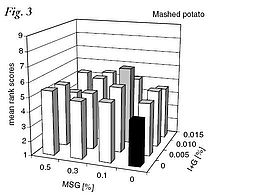Complex interplay: it is difficult to predict the hedonic effect of umami substances on foodstuffs
Sensory experts from the Faculty of Human Nutrition and Consumer Sciences at the Warsaw University of Life Sciences have ventured into a complex area of research. They examined what effect the addition of umami substances had on the taste of different foods. They came up with surprisingly differentiated findings.



Umami substances as monosodium glutamate (MSG) and 5’nucleotides are commonly used as additives to a variety of savoury foods (meat, fish, seafood, vegetable) for their flavour-enhancing properties. This unique ability has been described by Yamaguchi (1998) as “increase of continuity, mouth fullness, mildness and thickness of food”. However they are not suitable and remain ineffective in sweet, fruity, or bland foods (Yamaguchi, 1998; Yamaguchi & Takahashi, 1984).
MSG and 5’nucleotides as flavour enhancers are often used in mixtures because of their strong taste synergism (Fuke & Ueda, 1996). Therefore studies available in the literature are focused on the enhancing effect of MSG in combination with 5’nucleotides in foods. Another interesting aspect concerns sensory inter-relationship between umami substances and NaCl in food. It has been recognized that umami substances increase saltiness and improve the acceptance of low-salt foods. It is emphasised that in bland foods (such as rice), umami substances are ineffective when not accompanied by salt (Yamaguchi, 1987).
In spite of numerous literature sources on umami additives and its flavour enhancing effect in foods, there is little quantitative data showing how much the palatability is affected by rising MSG and I+G amounts singularly and in combination when added to various food types and compositions. Systematic research conducted by Polish food technologists and sensory scientists Bary?ko-Pikielna and Kostyra (2007) fulfils the gap. Palatability of seven products: six soups (chicken broth, mushroom, red-beet, pea, vegetable, and asparagus) and one second course side-dish (mashed potato) with rising levels of MSG (0-0.5%) and 1:1 mixtures of I+G (0-0.015%) and their combinations was systematically examined by a 20-member sensory panel using a hedonic ranking method.
Surprisingly, the researchers found no consistent pattern of hedonic response to the same amount or ratio of umami substances in the various investigated products. The results of the soups showing the strongest effects are shown in figures 1-3.
In mushroom soup the effect of both umami substances on the palatability was particularly strong (Fig. 1). Positive effects were achieved in moderate and high concentrations of MSG and 5’ribonucleotides with one exception (mixture of both umami substances at the highest level).
In the case of chicken broth the palatability rose distinctly with the MSG amount. In contrast, the addition of the mixture of IMP and GMP (I+G) seemed to be of secondary importance.
In red beet soup, a strong interactive effect of MSG in combination with I+G was observed. Optimal combination of umami substances was achieved within moderate range of these substances while the highest level of both, MSG and I+G caused a sharp decrease of soup palatability.
The pattern of hedonic changes in vegetable cream soup was somewhat similar to that in chicken broth although the palatability elevation was lower. Significant increase of hedonic value appeared at the moderate and highest concentration of MSG and the lowest level of I+G. However, moderate levels of MSG combined with the highest level of I+G resulted in a decrease in soup palatability. A similar compensation effect was found in asparagus cream soup.
A completely different and rather puzzling pattern of hedonic changes was evoked by the addition of umami substances was to green pea soup. Most combinations of MSG with I+G resulted in a decrease in palatability. – There was one exception: an increase in palatability with the addition of moderate levels of both umami substances) (Fig. 2).
Mashed potatoes appeared to be totally insensitive to the addition of umami substances (Fig. 3). One could observe only a very slight (not significant) increase of palatability as compared to the reference sample. There was one exception: a slight increase of palatability was observed when the lowest level of MSG was combined with a moderate concentration of I+G).
Nina Barylko-Pikielna and Eliza Kostyra concluded from these findings that: “The results have clearly shown that the optimal dose of umami substance for one product is not necessarily the best for another one.”
Generally MSG had a stronger influence on palatability than I+G. I+G had a more diverse impact on the various food matrices. In contrast to the finding of Yamaguchi (1998), in the watery solution of the soups no consistent synergistic effect between MSG and nucleotides was observed. It has been assumed that the various natural contents of free glutamic acid and glutamates as well as 5’ribonucletides in the investigated products could be a possible source of the observed diversity and individuality of responses to the same amount or ratio of added umami substances. While the added umami substances were quantitatively controlled, the naturally occurring umami substances were not taken into account – although they both contribute to the taste quality perceived by the human senses.
Umami substances
|
References:
Barylko-Pikielna N. & Kostyra E. (2007). Sensory interaction of umami substances with model Food matrices and its hedonic effect. Food Quality & Preference, 18, 751-758.
Fuke, S. & Ueda, Y. (1996). Interaction between umami and other flavor characteristics. Trends in Food Sciences & Technology, 7, 407-411.
Yamaguchi, S. (1987). Fundamental properties of Umami in human taste perception, In: Kawamura Y., Kare M.R., editors. Umami a basic taste. New York: Marcel Dekker, 41-73.
Yamaguchi, S. (1998). Basic properties of umami and its effects on food flavour. Food Reviews International. Special issue on umami. 14, 2&3, 139-176.
Yamaguchi, S., & Takahashi, Ch. (1984). Interactions of monosodium glutamate and sodium chloride on saltiness and palatability of a clear soup. Journal of Food Science. 49, 82-85.
Source:
Nina Barylko-Pikielna